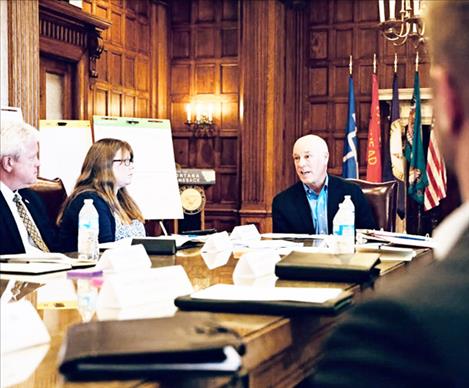Governor Gianforte’s Housing Task Force holds first meeting
Hey savvy news reader! Thanks for choosing local.
You are now reading
1 of 3 free articles.
HELENA — On July 20 Governor Greg Gianforte joined members of the Governor’s Housing Task Force for its first meeting.
“Nationwide, we have seen prices soar in recent years as housing supply has sputtered, along with a confluence of other factors. Montana is not immune to those trends,” Gov. Gianforte said in opening remarks to the task force at the State Capitol. “When it comes down to it, the health and wellbeing of our families, our communities, our businesses, and our economy rely on access to affordable, attainable housing. And right now, finding affordable, attainable housing is a massive challenge to Montanans.”
The governor charged the task force, which he created through an executive order, with providing recommendations the legislature could consider and the governor could sign into law to make housing more affordable and attainable. Gov. Gianforte also charged the task force with developing recommendations state agencies can implement administratively as well as recommendations and best practices local jurisdictions can enact.
Highlighting macroeconomic trends driving up the cost of housing, Gov. Gianforte noted Montana’s population grew by nearly 10 percent between 2010 and 2020, while housing units have grown by less than 7 percent. Over that same period, the rental vacancy rate in Montana dropped from nearly 6 percent to slightly more than 4 percent. In some areas in the state, the rental vacancy rate hovers at or below 1 percent.
Driven by increased consumer demand, rising inflation, and national supply chain breakdowns, the cost of building a new home has soared, with private residential construction costs skyrocketing 18.4 percent nationally between March 2021 and March 2022, according to the U.S. Census Bureau.
Gov. Gianforte also noted some of the blame for the state’s shortage of affordable, attainable housing rests with government at all levels, saying “Strict zoning and other housing supply regulations are a wet blanket on responsible development and growth. They increase costs and limit supply. In fact, the National Association of Home Builders estimates that the average cost of housing regulation in the price of a new home soared 44 percent in the last decade.”
The National Association of Home Builders (NAHB) also reported that government-imposed regulations account for 23.8 percent of the final price of a new single-family home built for sale.
State agency leaders, a bipartisan group of legislators, local officials, association representatives, economists, researchers, stakeholders, and advocates make up the task force.
Gov. Gianforte appointed Chris Dorrington, director of the Department of Environmental Quality, to chair the task force. At today’s meeting, task force members named Todd O’Hair, president and CEO of the Montana Chamber of Commerce, to be the task force’s vice chair.
“Every day, Montanans work hard to realize the American dream: to earn a decent living, to raise a family, to contribute to their communities, to retire comfortably, and to own a home,” Gov. Gianforte concluded. “Government should not stand in the way of Montanans striving to achieve those core elements of the American dream. Unfortunately, there are ill-advised federal, state, and local policies that create unnecessary roadblocks to home ownership. Let’s remove them. Let’s help more folks achieve the American dream.”
During the meeting, the task force also created four subcommittees charged with specific focuses and named co-leads for each subcommittee.
More details about the task force – including meeting dates, agendas, and materials – and a portal for public comment and engagement may be found on the Department of Environmental Quality’s website.
















